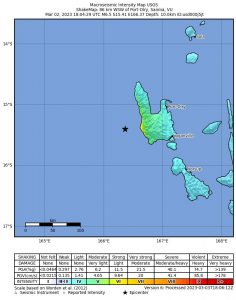Vanuatu starts recovery after cyclones Judy, Kevin roll through the South Pacific
[credit]Credits: Kin L., Force Thirteen[/credit]
The Pacific island nation of Vanuatu has declared a state of emergency after two cyclones moved over the nation, with Cyclones Judy and Kevin. The nation had also felt a strong earthquake which affected recovery efforts from the former.
Cyclone Judy: A Recap
Cyclone Judy was a Category 4 tropical cyclone in the Australian scale, and a Category 3-equivalent storm in the Saffir-Simpson scale by Force Thirteen analysis, that affected Vanuatu in March 1.

The system formed from a tropical disturbance near Samoa on February 22, moving west-southwest before intensifying into a tropical storm by F13 analysis on the 27th. While turning more southeastwards as it intensified, it moved over the nation, and soon over the island of Efate, where the capital Port Vila was placed. At the time of its landfall, Force Thirteen had Judy as a Category 2-equivalent cyclone in the SSHWS, with 1-minute winds of 155 km/h (100 mph).
Judy’s stay over the island was short, and as it emerged over the Pacific once again, it took off, developing an eye on satellite imagery. F13 then estimated Judy to have reached Category 3-equivalent status at 2pm local time, as it was moving over the island of Erromango. It reached its peak intensity three hours later, with winds of 195 km/h (120 mph). After its landfall, it was all downhill for the cyclone. Wind shear effectively stripped away its structure, and it transitioned into an extra-tropical cyclone today.
According to the Solomon Star, a dozen houses were destroyed by tidal waves generated by the storm in the Solomon Islands. Heavy rain and gale to hurricane-force winds pummeled Vanuatu as Judy moved through. After Judy swept through the nation, another disaster struck the region.
Earthquake strikes near Espiritu Santo

A day after Judy left Vanuatu, a magnitude 6.5 earthquake struck to the west of the island of Espiritu Santo, according to the U.S. Geological Survey (USGS). It then generated an aftershock of a magnitude 5.4 after the initial quake.
No casualties were reported after the earthquake, but communication from all of Vanuatu’s islands remained affected, along with electricity. People couldn’t go out and assess the damage of the quake due to strong winds, according to the secretary-general of the Vanuatu Red Cross Society Dickinson Tevi.
Under Judy’s shadow: Cyclone Kevin
Cyclone Kevin initially formed as a tropical low to the east of Queensland in Australia on February 27, before moving into the South Pacific basin on March 1, right when Judy made its landfall over Efate and Erromango. It then intensified into a tropical storm in the morning of the next day locally.

Intensification was gradual, and by the time Kevin approached Vanuatu, it was nearly a high-end storm, before making landfall over Erromango with 1-minute sustained winds of 110 km/h (70 mph) by F13 analysis. Port Vila was fortunately not within the eyewall of the cyclone, but it was within the storm nonetheless.
After its landfall, Kevin explosively intensified, with the Joint Typhoon Warning Center describing it as a “meteoric development”.
Over an 12-hour period starting from its emergence from land, Kevin immediately cleared out its eye, which made its intensity soar to major cyclone status by the morning of March 4. It ultimately peaked as a Category 5 severe tropical cyclone on the Australian scale, and a Category 4-equivalent cyclone in the SSHWS by F13 analysis, with 1-minute sustained winds of 240 km/h (150 mph), just shy of Category 5 status.
Now, Kevin is rapidly weakening, with its eye no longer visible on satellite imagery. It is not expected to affect any land as it continues southeastward.
A state of emergency was declared in Vanuatu as Kevin moved through the nation. Officials are working to assess the damages caused by both cyclones, according to Vanuatu Prime Minister Ishmael Kalsakau. The government of Australia has pledged to help Vanuatu, as they’ll be sending a 12-person assessment team and emergency supplies like shelters and water equipment. The Royal Australian Air Force will also help with aerial damage assessments.

